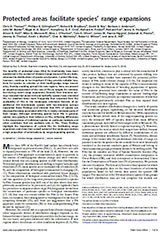Publications
Protected areas facilitate species' range expansions
| Year of publication | 2012 |
|---|---|
| Author(s) | Chris D. Thomas |
| Co-authors | Phillipa K. Gillingham, Richard B. Bradbury, David B. Roy, Barbara J. Anderson, John M. Baxter, Nigel A. D. Bourn, Humphrey Q. P. Crick, Richard A. Findon, Richard Fox, Jenny A. Hodgson, Alison R. Holt, Mike D. Morecroft, Nina J. O’Hanlon, Tom H. Oliver, James W. Pearce-Higgins, Deborah A. Procter, Jeremy A. Thomas, Kevin J. Walker, Clive A. Walmsley, Robert J. Wilson, and Jane K. Hill |
| Publisher(s) | Proceedings of the National Academy of Sciences PNAS Website: http://www.pnas.org |
| Language | en |
| Purchase | http://www.pnas.org/content/early/2012/08/14 |
| Journal | PNAS |
| Page(s) | 10 |
| Magazine No. | Vol. 109 no. 35 |
| Publication type | Journal article |
The benefits of protected areas (PAs) for biodiversity have been questioned in the context of climate change because PAs are static, whereas the distributions of species are dynamic. Current PAs may, however, continue to be important if they provide suitable locations for species to colonize at their leading-edge range boundaries, thereby enabling spread into new regions. Here, we present an empirical assessment of the role of PAs as targets for colonization during recent range expansions. Records from intensive surveys revealed that seven bird and butterfly species have colonized PAs 4.2 (median) times more frequently than expected from the availability of PAs in the landscapes colonized. Records of an additional 256 invertebrate species with less-intensive surveys supported these findings and showed that 98% of species are disproportionately associated with PAs in newly colonized parts of their ranges. Although colonizing species favor PAs in general, species vary greatly in their reliance on PAs, reflecting differences in the dependence of individual species on particular habitats and other conditions that are available only in PAs. These findings highlight the importance of current PAs for facilitating range expansions and show that a small subset of the landscape receives a high proportion of colonizations by range-expanding species.


